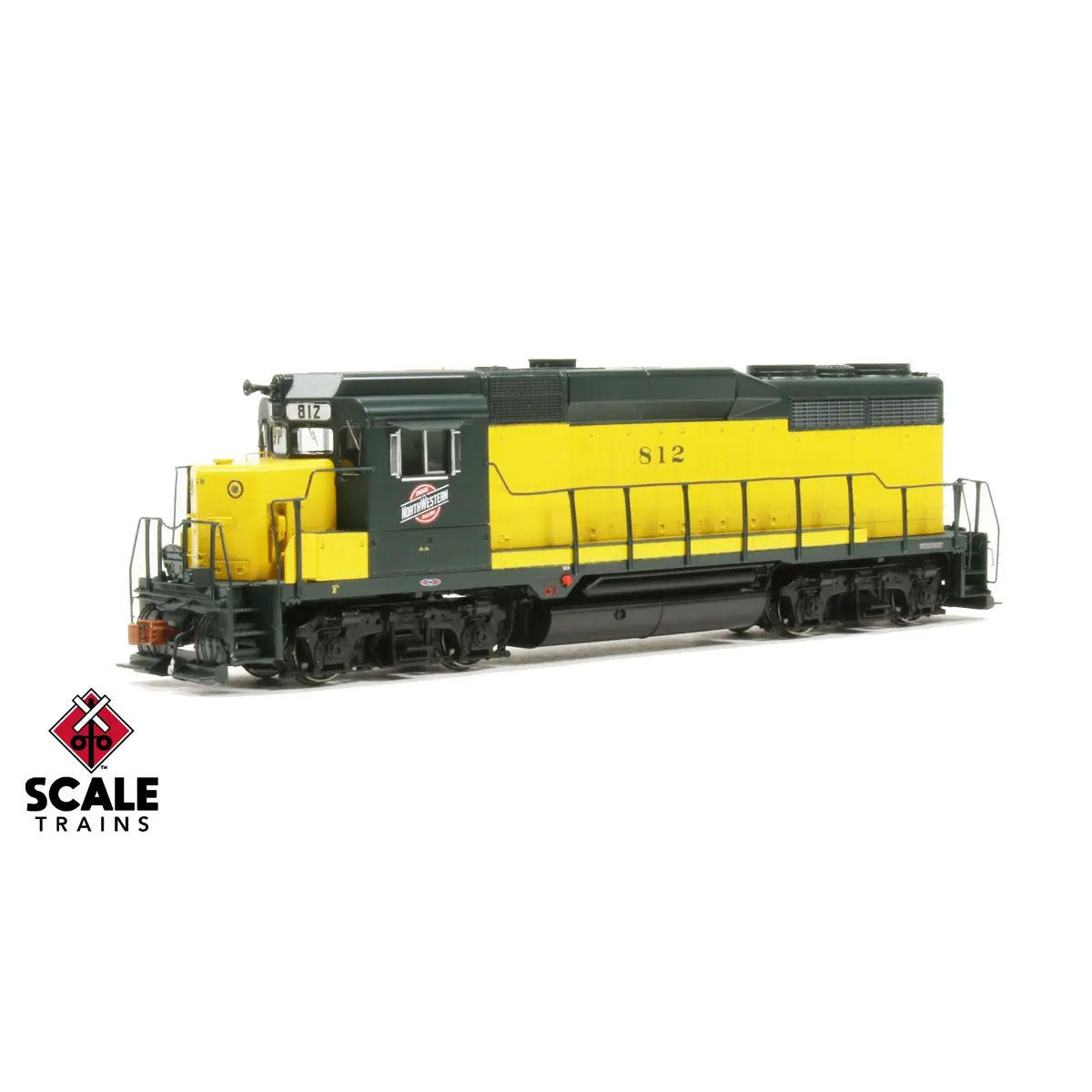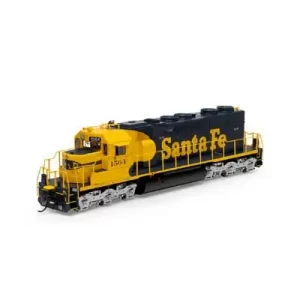Description
Railroad Short Name: CNW
The arrival of the U25B in 1959 and the interest it drew from the railroads meant EMD would revamp its designs to meet the challenge from the newcomer. The basic GP7/9/18/20 platform was stretched slightly to allow for a larger fuel tank for increased range and tractive effort. Having proven the advantages of turbocharging in the predecessor GP20, the turbocharged 16-567 prime mover was retained, though receiving a slight boost to 2,250hp. The biggest change came in the carbody design, which featured an all-new main electrical cabinet at the rear of the cab, which drastically changed the cab height and profile in comparison to the GP20. EMD would also introduce a centralized air system as well, with an inertial air intake and filtration system to provide clean pressurized air to the locomotive. And in an unusual twist, EMD engineers would turn to parent GM’s automotive styling department to help blend all of these new features into the carbody.
The result of all of these design features was … the GP22. With its model number falling in line with its horsepower rating and EMD’s numbering system at the time, this new demonstrator locomotive for 1961 looked like no other in the EMD lineup. The taller electrical cabinet, combined with the styling input from GM, created a “humpback” from the cab back, extending into the inertial air filter compartment, ending in fairings that straddled the roofline and concealed optional dynamic braking equipment. Coming with a low-short hood as standard, the cab face featured a “vee” profile, offering improved visibility and reduced glare for the crew. The cab front roofline was set back in a unique brow, and the flat cab roof rolled gracefully down on each side into a stepped fairing, all blending into the long hood roofline.
The demo unit, numbered 5629, quickly set out to prove its capabilities and features to the railroads. But before long, EMD would re-designate its new general-purpose unit the “GP30”, mainly as a marketing move, the rationale being the model number “30” being greater than the “25” of the competition. They would also tout “30” design features and improvements over previous models. This change, along with a return trip to LaGrange for a new demonstrator paint scheme and some styling tweaks to the carbody that would give it the definitive GP30 “look”, would set the stage for the GP30’s arrival on the railroad scene.
Features:
- Era: 1963 to 1986
- Series 810 to 823, built 4/69, Phase Ie
- Road numbers 812, 815, 817, 819, and 823
- “OY” Scheme – battery box doors, front kickplates, sides of the traction motor blower duct, and rear kick plate are painted yellow
- Road number 821
-
- “OY” Scheme Repaint – battery box doors, front kickplates, sides of the traction motor blower duct, and rear kick plate are painted green
- Fully-assembled
- Multiple road numbers
- Operating LED-illuminated ground lights on both sides of locomotive*
- Operating LED-illuminated “hemisphere” walkway lights on hood ends, and at end of raised walkway duct*
- Operating LED-illuminated tricolor front and rear flush-mounted class lights with lenses and raised gaskets**
- Cab and rear number boards *
- Front and rear multiple unit (MU) hose catch boxes with footboards
- 4-hose multiple unit (MU) hose clusters with silver gladhands
- Semi-scale coupler buffer equipped with durable metal semi-scale Type E knuckle couplers
- Front and rear straight uncoupling levers without loop handles
- As-delivered pilot faces without uncoupling lever loop notches
- Deck-mounted multiple unit (MU) receptacle
- “Short” stepwells with see-through steps
- Handrail set with center gangway chains
- Front and rear standard drop steps
- Scale sectioned treadplate detail with EMD early “X” style pattern
- 81” GP30 low short hood with ratchet handbrake, square sand fill, and round sandbox cleanouts
- Hinged battery box doors with early hinges and narrow louvers
- Early cab sub-base doors with early hinges
- Front standard EMD LED-illuminated headlight with lenses on number board housing
- GP30 cab with increased length on left (fireman’s) side and inverted cab heater vents
- Detailed cab interior with separate floor, rear wall, seats, and standard AAR control stand
- Sliding cab side windows
- Tall mirrors mounted fore and aft of cab side windows on both sides of cab
- Standard EMD sunshades with long sunshade tracks
- Lost-wax brass cast Leslie SU-3L-R horn mounted on right side cab eave
- Accurate hood door and long hood detail
- Late single-panel inertial compartment
- Wire inertial air intake grills
- Tall turbo exhaust stack
- Non-dynamic brake housing with blanked intakes and fan
- Late See-through dynamic brake intake grills with horizontal wires through vertical vanes
- 7-horizontal rib radiator intake grills
- See-through front and rear 48” radiator fan housings with 8-blade fans; 36” cap-top center radiator fan
- Straight radiator fan grab iron
- Square sand fill hatch on top of long hood end
- Rear LED-illuminated horizontal headlight with lenses
- Underbody frame rails with separate plumbing
- Detailed Blomberg-B trucks with square and sloped bearing housings; elliptical springs; end transom detail; separate sanding lines and brackets; and separate swing hanger detail
- Dimensionally accurate truck centers
- Speed recorder mounted to second axle on right front truck sideframe
- Frame-mounted bronze bell
- No underbody air filter
- 2,600-gallon fuel tank with vertical gauges and fuel fill in sill skirt; round gauges in fuel tank sides
- Factory-applied wire grab irons, photoetched lift rings, windshield wipers, trainline hoses with silver gladhands, air tanks, sand hatch covers and more
- Motor with 5-pole skew-wound armature
- Dual flywheels
- All-wheel drive
- All-wheel electrical pick-up
- Directional LED-illuminated headlights
- Printing and lettering legible even under magnification
- Primary body colors match Tru-Color Paint colors:
-
- TCP-108 C&NW Yellow
- TCP-109 C&NW Green
- Operates on Code 70, 83 and 100 rail
- Packaging safely stores model
- Minimum radius: 18”
- Recommended radius: 22”
DC/DCC & sound-ready locomotives also feature:
- Operable on DC layouts
- DCC-ready with 21-pin connector








Reviews
There are no reviews yet.